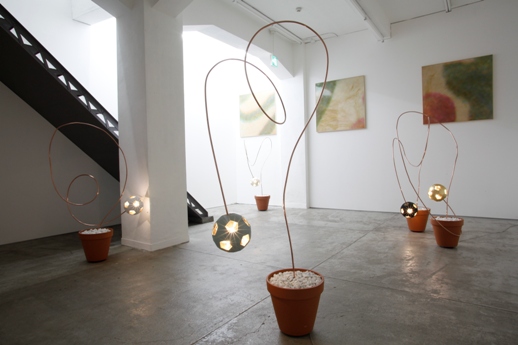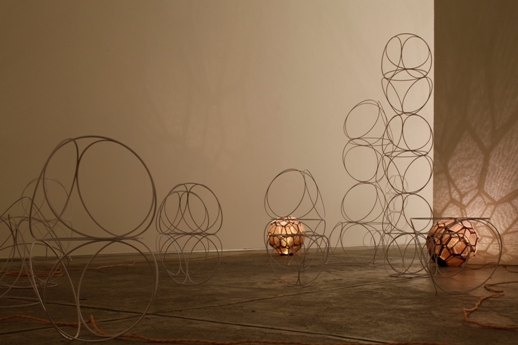The Urban Jungle
The very first thing I see when I enter TARO NASU, before the nod to the woman standing behind the desk, is a white wireframe hexahedron. It sits on a beam over the descending stairs beyond the heavy double doors, as if it began to grow there and the staff did not want to clear it away. I take the stairs down, and ten minutes pass before I realize the shape is part of the exhibit.
When TARO NASU moved into its Bakurocho basement in 2008, it was architect Jun Aoki who designed the brightly-lit white space. For “Midsummer Plants” Aoki has taken the helm again, turning off the lights and filling the gallery’s two rooms with plant-like sculptures that give off a soft glow.
In the first room stand six potted plants, their stems of copper tubing bursting from the flower bed in joyous swoops. They are topped by plump, spherical buds lit from the inside by diodes. They sway slightly in the still air. Afternoon light trickles in from the windows above the stairs. I think about what the exhibit would look like if TARO NASU were open past seven, with only the diffuse glow from within the works themselves.

I imagine families and couples taking picnics here, pointing to fireflies dancing within the shady growth. An audio player tucked into a corner at the back of the gallery produces intermittent notes, as if water were falling from the roof of a cave and onto tinkling bells of glass.
A barrier has been constructed between the first and second rooms, columns of styrofoam one story high, sheared at the top like a picket fence. Crossing, I leave a cultivated grotto for more wild parts.
In the second room there are no windows, and the buds creep along the ground, spreading like pumpkins from long tendrils of electrical cabling. At the very back the plants have turned brown, cracked and dried. Here I see more of the wireframe shapes from the entrance. They dominate the ecosystem, as if the dying buds have shed their substance and their inward glow until only the most basic skeleton of their shape remains. The still room fills with the music of dripping.

This short trip, from potted plants to untended cave, is repeated in reverse on the way out. Seclusion gives way to cultivation and at last, up the steps and out into the Tokyo sunlight I am back in the bustling cityscape, where geometry and biology battle in a different way.
Aoki’s plants exist as an uneasy truce between the insistent spread of nature into the most hostile environments, and the man-made materials that dominate Tokyo’s landscape. The plants, in gold, silver, deep blue, white and turquoise, made from wires and plastics and copper and fabrics, celebrate their own existence, shout, “look, we can grow here too.”
TABlog featured a photo report on the closing night in 2008 of the old Roppongi galleries’ building that previously housed TARO NASU.
Matthew Hayles
Matthew Hayles



